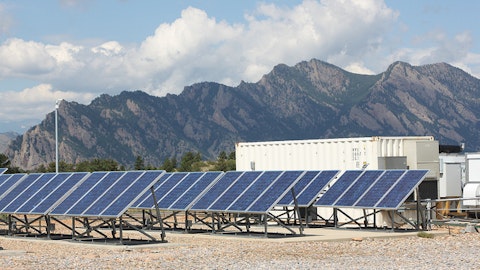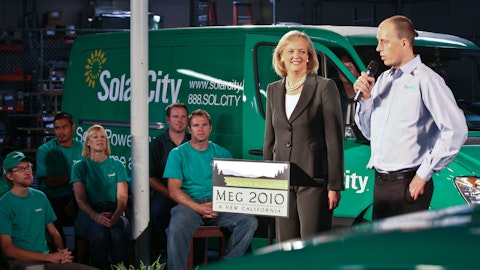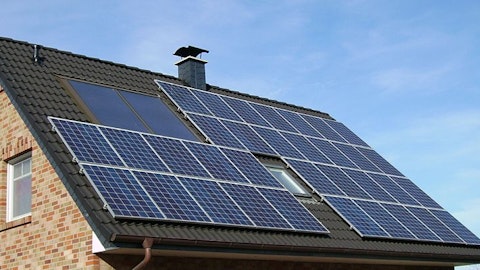SolarCity Corp (NASDAQ:SCTY) is in the news after the company announced a technology breakthrough and a bearish hedge fund manager slammed it afterwards. Jim Chanos of Kynikos implied SolarCity was being disingenuous after SolarCity announced the cost of a new uber-efficient panel would be $0.55 per watt by 2017. Chanos noted that similar panels made in China would be as low as $0.30 per watt by 2017. Shares of SolarCity rallied more than 7.29% on Friday, but are down 13% year-to-date. Let’s examine SolarCity in depth and see how the smart money feels about the renewable tech company.

We mention the hedge fund activity concerning SolarCity Corp (NASDAQ:SCTY), because our research has shown that historically their stock picks delivered superior risk-adjusted returns. This is especially true in the small-cap space. The 50 most popular large-cap stocks among hedge funds had a monthly alpha of about six basis points per month between 1999 and 2012; however the 15 most popular small-cap stocks delivered a monthly alpha of 80 basis points during the same period. This means investors would have generated a double-digit alpha per year simply by imitating hedge funds’ top 15 small-cap ideas. We have been tracking the performance of these stocks since the end of August 2012 in real time and these stocks beat the market by 60 percentage points (118% return vs. the S&P 500’s 57.6% gain) over the last 37 months (see the details here).
Follow Solarcity Corp (OTC:SCTY)
Follow Solarcity Corp (OTC:SCTY)
Receive real-time insider trading and news alerts
From SolarCity’s investor relations:
“SolarCity (NASDAQ: SCTY) has built the world’s most efficient rooftop solar panel, with a module efficiency exceeding 22 percent. The new SolarCity panel generates more power per square foot and harvests more energy over a year than any other rooftop panel in production, and will be the highest volume solar panel manufactured in the Western Hemisphere.
SolarCity’s new panel—created via a proprietary process that significantly reduces the manufacturing cost relative to other high-efficiency technologies—is the same size as standard efficiency solar panels, but produces 30-40 percent more power. SolarCity’s panel also performs better than other modules in high temperatures, which allows it to produce even more energy on an annual basis than other solar panels of comparable size.”
SolarCity’s technology breakthrough is important, because it makes the company more competitive. The company used to install and finance solar panels, but not produce them, and changed its mind after the US imposed tariffs on Chinese panels beginning in June of last year. Management bought domestic solar module maker Silevo later in the month to take advantage of those new duties. With the new high efficiency panels, SolarCity can offer its customers a better value and realize greater margins per installation.
Chanos’ comment on Chinese cost per watt is relevant, but would be more relevant if the U.S. rolled back the tariffs on Chinese solar imports. The investor is short SolarCity and thinks the company is similar to a subprime financing company, because many of SolarCity customers might default once solar prices fall substantially. So far solar prices have not fallen far enough to prove Chanos right. Chanos doesn’t think SolarCity should trade for more than 1.3 times tangible book value, or roughly $10 per share.
However, overall, hedge funds are bullish on SolarCity, since they amassed almost 25% of the company at the end of June (see how it ranked among other renewable energy stocks). Of the around 730 funds we track, 34 held stakes worth $1.28 billion in aggregate at the end of the second quarter, compared to 36 funds with positions valued at $1.02 billion on March 31. Karthik Sarma‘s SRS Investment Management owns 8 million shares, while Joshua Friedman and Mitchell Julis’ Canyon Capital Advisors owns 3.03 million shares. John Burbank’s Passport Capital holds 2.84 million shares too. Currently, around 44.8% of SolarCity’s float are short with Chanos being one of them.
Although SolarCity shares are down 13.2% year to date, the stock has performed better than its peers. SolarCity has largely sidestepped the solar yieldco carnage caused by low crude prices and is growing rapidly. Management will need to execute well as rising interest rates and expiring tax credits are on the horizon.
Disclosure: none




